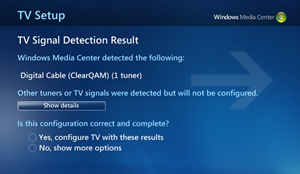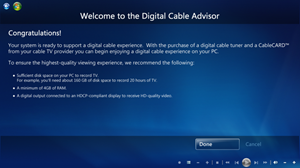We’ve been using Windows Media Center as our home’s main DVR for several years now. We have basic cable service, and over the past few months, my cable company has started to switch some of our channels from analog delivery over to their digital service.
This type of change has become more and more common for cable companies over the past year or so, as a quick search on TheGreenButton.com (TGB), our community for Windows Media Center enthusiasts will show. What’s more, there are a few different types of changes going on with cable providers, and people are turning to TGB to help keep their Windows Media Center PCs in step with the changes.
Here are some of the most common scenarios we’re seeing, and some of the options you have for keeping your Windows Media Center PC in step with any changes your provider may be making.
You have analog tuners and your cable company is transitioning to digital service….
Perhaps the most common change we’re seeing in the US is that many cable companies are changing from analog delivery to digital, which allows them to deliver more channels and services more efficiently. In most cases, if you have Windows Media Center configured with a set-top box (STB) provided by the cable company, you’re already in good shape for this change.
Configuring with a set-top box…
Most standard set-top boxes also support low-res capture out through their S-video or composite connectors via a NTSC (analog) TV tuner. Even if your cable company has turned off the analog support, the current digital set-top boxes are capable of decoding a digital signal and converting it into an analog output. This solution allows you to keep your analog tuners and still be able to access analog channels. It does require you configure Media Center to control the set-top box, which means the IR receiver for your Windows Media Center remote control needs to have an attached IR transmitter (commonly called an ‘IR blaster’), a wire with transmitter on the end that you attach to your set-top box to allow Windows Media Center to control channel changing.
A down side to this set-up is that it provides a standard definition experience, even when you’re tuning in to high definition programming. However, if you have an HD Cable box, one workaround we are seeing enthusiasts try out involves adding in a product like the Hauppauge HD PVR box or the Monsoon HD Platinum from Hava, which allows you to do higher resolution captures (up to HD 1080i) analog component capture from your set-top box. (As an aside, this is also a good workaround if you are a satellite subscriber, since it enables HD capture from your component video even though there are no satellite tuners currently available for Windows Media Center.) One community member on The Green Button has written up a decent how-to on configuring a product like this with Windows Media Center.
Ask for an Adapter…
In my case, with my service changing over to digital transmission, I can also request that our cable company provide me with a digital transport adapter (DTA). This is essentially a small set-top box that will convert the digital signal to analog before it reaches the analog tuner in my Windows Media Center PC. This set-up requires IR blasting and has the same limitations as a set top box configuration, but it can be a good low cost option if you want to extend the life of those analog tuner cards you already have.
Many users over on The Green Button have indicated that their cable company has provided the DTA free of charge. Long time Windows Entertainment and Connected Home MVP Barb Bowman has written a great how-to on setting up a DTA with Comcast cable that will give you a good overview of setting up this solution.
Skip the Set-top Box…
There are good reasons to skip a set-top box set-up, however. This is especially true if you have more than one tuner, because in this case, the STB configuration requires more than one cable box, and many people prefer to avoid the expense of leasing additional set-top boxes. Thanks to Windows 7, the good news is that you have more options now than ever before.
Upgrade your TV tuners: QAM and CableCARD™ explained
In my case, I can also upgrade the tuners in my PC to accommodate the change. Since we have basic cable, I can start with a relatively inexpensive QAM tuner, which will receive all unencrypted digital content sent by my cable provider.
The key word here is unencrypted…what each cable company chooses to encrypt or not seems to vary by provider. In our case, all of my local network affiliate channels can be tuned by a QAM tuner, but the rest of my basic package is encrypted. Others have had more luck with a QAM tuner, actually finding more channels than they had originally.
It’s worth noting, too, that many of today’s hybrid or dual TV tuners support both QAM along with the analog NTSC. In my case, I simply re-ran TV set-up in Windows Media Center and selected the QAM (Digital Cable) tuner that Windows Media Center found instead of the analog NTSC tuner.
In addition, there are solutions like the SiliconDust HDHomeRun tuners which provide a networked tuner setup. This enables the tuner to be in a different room than the PC, which is helpful if you do not have a cable feed in the same room as your PC, though it does require a network to be able to connect the PC to the tuner.
Take it to the next level: CableCARD™ Tuners
The option many enthusiasts are embracing involves upgrading to a CableCARD tuner like the recently released Ceton InfiniTV 4, which allows you to receive all of your digital content – both encrypted and unencrypted, in full high definition (when applicable). In this case, your cable company provides you with a CableCARD™ that slides right in to the tuner itself to handle decrypting the signal for you – no set-top box required. This is a popular option if you subscribe to a lot of premium channels and receive a lot of high definition content as part of your cable package.
Ceton’s tuner lets you watch or record up to four high definition programs at once, and as of this writing is the only CableCARD tuner on the market. As many enthusiasts on TGB will attest, there is currently a wait to get one. However, some other companies have also announced their intentions to bring CableCARD-based tuners to the market. There’s also a bustling second hand trade in the now-discontinued first-generation CableCARD tuners from ATI on eBay and in TGB’s for sale forum. If you go down this route, you need to make sure that a first generation CableCARD tuner will work with your provider – as many FiOS customers know, when a provider rolls out a technology called Simulcrypt, first generation CableCARD tuners will no longer function.
Run the Digital Cable Advisor!
Before you go down the CableCARD route, be aware that you need to be running a version of Windows 7 that includes Windows Media Center, and that you need to run the Digital Cable Advisor Tool first. This tool is found within Windows Media Center (Extras Gallery | Digital Cable Advisor), and it will test the specifications on your system to ensure they meet the minimum requirements for running a CableCARD-based tuner.
If your system passes, it is then enabled to support a CableCARD tuner. If it doesn’t pass, the tool makes recommendations as to which components may need to be upgraded in order to support the experience.
Above: Now my Windows 7 PC is ready for a CableCARD™ tuner like Ceton’s InfiniTV4.
Beyond this change over to digital signal transmission, there are a few other changes that some companies have been making over the past year. A sampling:
My cable company is rolling out Switched Digital Video (SDV) on some channels
Another change we’re seeing some cable providers make is the use of Switched Digital Video, or SDV, a technology which delivers digital video with more efficiency and maximizes the available bandwidth.
If you are using Windows Media Center with a CableCARD tuner and your cable company is rolling out SDV on some channels, then the provider should give you a Tuning Adapter (TA) – a box that connects to the USB port of the PC and the coax line to send requests back to the provider’s head end to “turn on” channels when they are selected. The number of SDV Tuning Adapters you need will vary. If you are using the first generation ATI cable card tuners, you need one TA for each tuner. If you have a Ceton InfiniTV quad CableCARD tuner, you will need at least one TA, and possibly two, depending on the type of CableCARD your cable provider uses. If you are not sure, contact your cable provider, or refer to help on TheGreenButton forums to understand requirements in your area.
Ideally, if you order a CableCARD for your Windows Media Center PC, your provider’s service rep should know whether or not you will need a tuning adapter, and can make sure you get one if needed. Reports on TGB suggest, however, that you may need to be bumped up to a higher level tech support rep to get the right answer on this.
I have FiOS and have heard there is a change coming…
A final scenario we’re seeing is among subscribers who get their television content via fiber optic services like Verizon’s FiOS TV. Some of these providers are implementing a technology called Simulcrypt, which allows them to offer their service with a wider range of set-top boxes. This change will only affect you if you’re running one of the now-discontinued first generation of CableCARD tuners from ATI. If that’s the case, unfortunately you’re only option is to upgrade to a new CableCARD™ tuner. This is because the ATI firmware doesn’t support Simulcrypt, and with the product now discontinued, there’s little hope of an update.
I know something is changing, but I’m still not sure what it is…
One of the problems driving folks to The Green Button is that the letters they receive from their cable companies don’t make it clear how a Windows Media Center set-up might be impacted by the change that’s being communicated. If this is the case for you, then turn to the community on TGB – you’ll likely find folks who can tell you what the change is and how you’ll be impacted. You might even hear from other WMC users in your area or with the same provider who can share their experiences with you.




